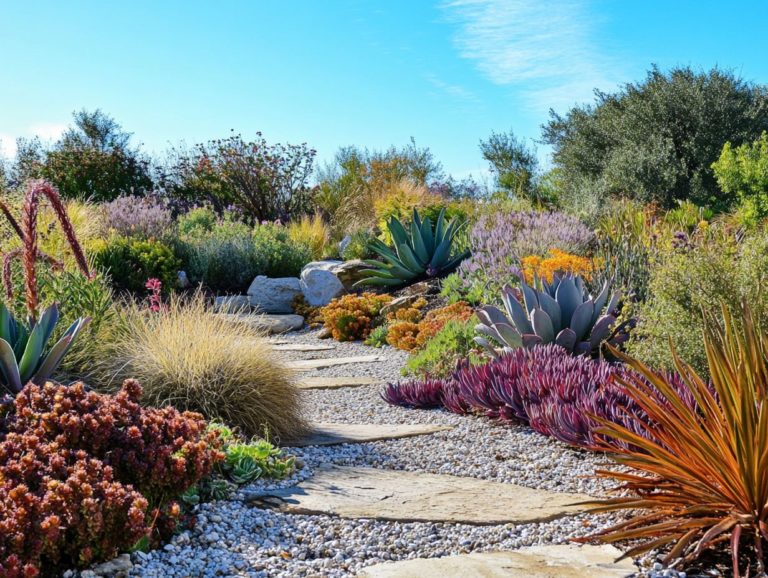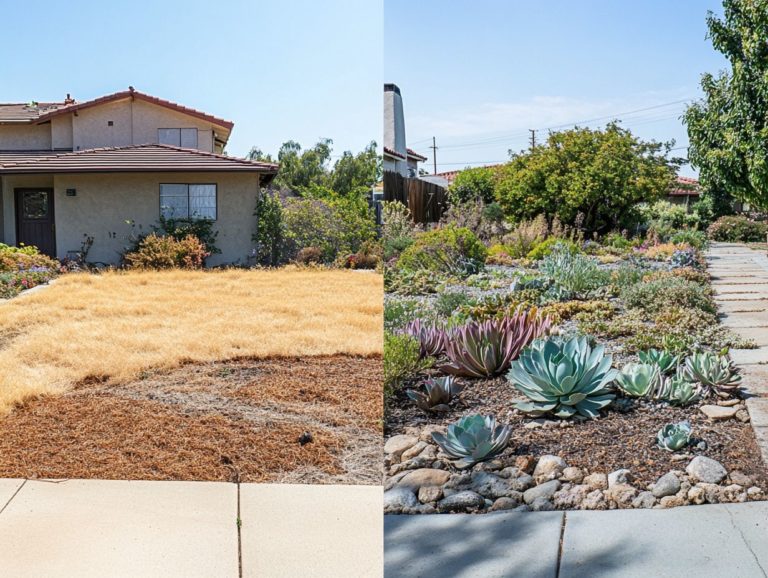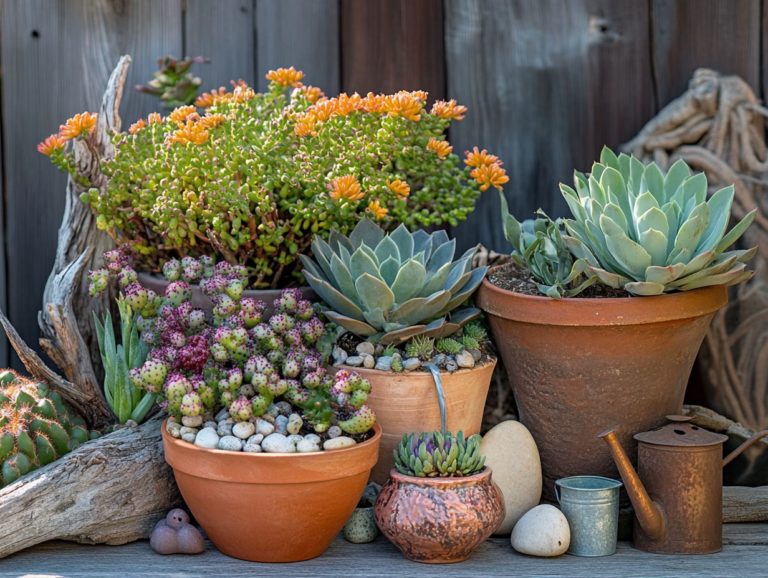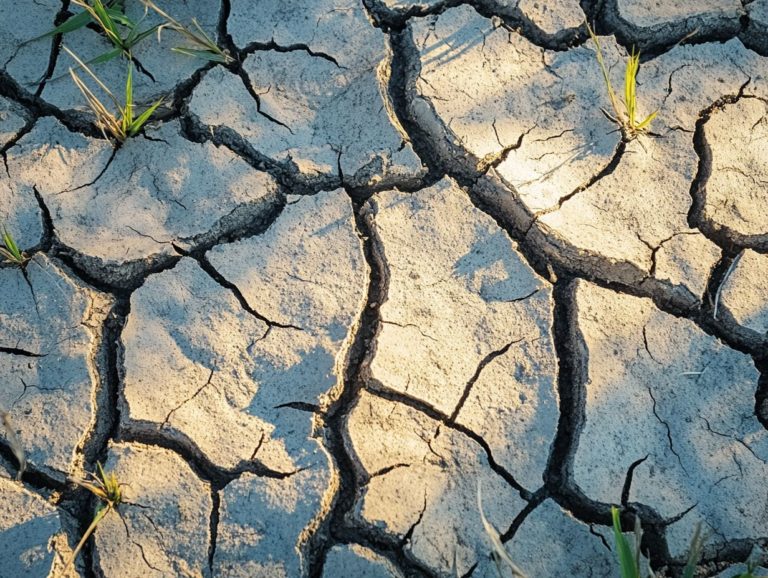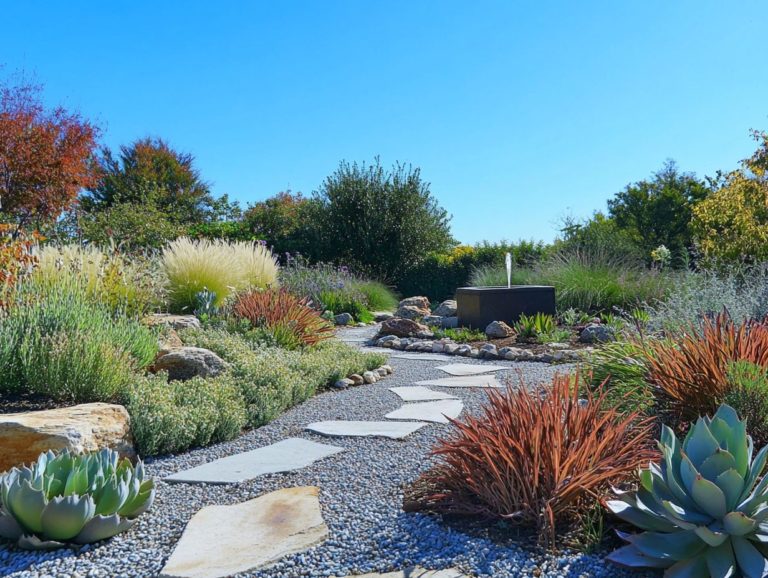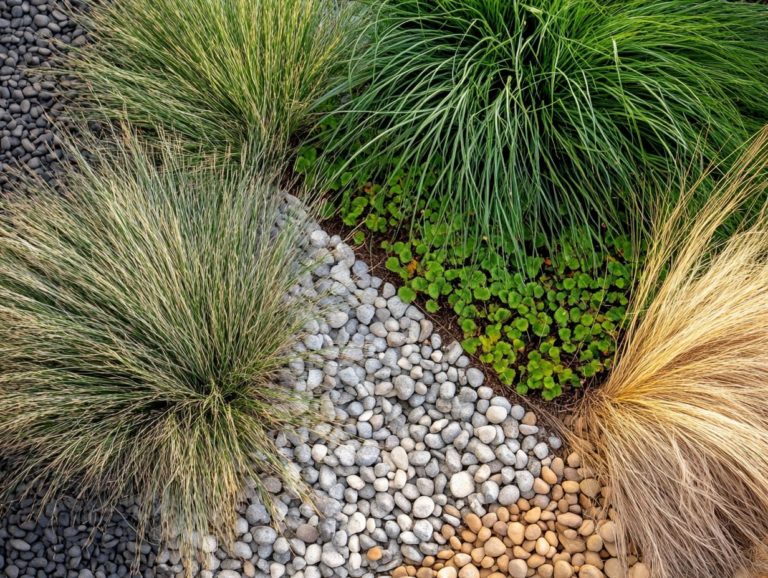5 Essential Tips for Drought Landscaping
Drought landscaping is becoming increasingly crucial as water shortages become more frequent. By embracing water-wise practices, you can cultivate a vibrant garden that not only survives but thrives in dry conditions.
This article presents five essential tips to guide you in designing a garden that can survive drought, from selecting native plants to implementing rainwater harvesting techniques.
Explore practical strategies that conserve water, enhance biodiversity, and elevate your outdoor space. Discover the art of creating a garden that is both stunning and sustainable.
Contents
- Key Takeaways:
- 1. Choose Native Plants
- 2. Group Plants with Similar Water Needs
- 3. Use Mulch to Retain Moisture
- 4. Install Drip Irrigation Systems
- 5. Implement Rainwater Harvesting
- What Is Drought Landscaping and Why Is It Important?
- What Are the Benefits of Using Native Plants in Drought Landscaping?
- How Can Grouping Plants with Similar Water Needs Help Conserve Water?
- What Are the Different Types of Mulch and How Do They Help Retain Moisture?
- What Are the Advantages of Using Drip Irrigation Systems in Drought Landscaping?
- How Can Rainwater Harvesting Help with Drought Landscaping?
- What Are Some Other Water-Saving Tips for Drought Landscaping?
- Frequently Asked Questions
- What does drought landscaping mean?
- Why is drought landscaping important?
- What are the 5 essential tips for drought landscaping?
- What are some examples of drought-tolerant plants?
- What are some water-saving design techniques for drought landscaping?
- How often should you monitor and maintain a drought landscape?
Key Takeaways:
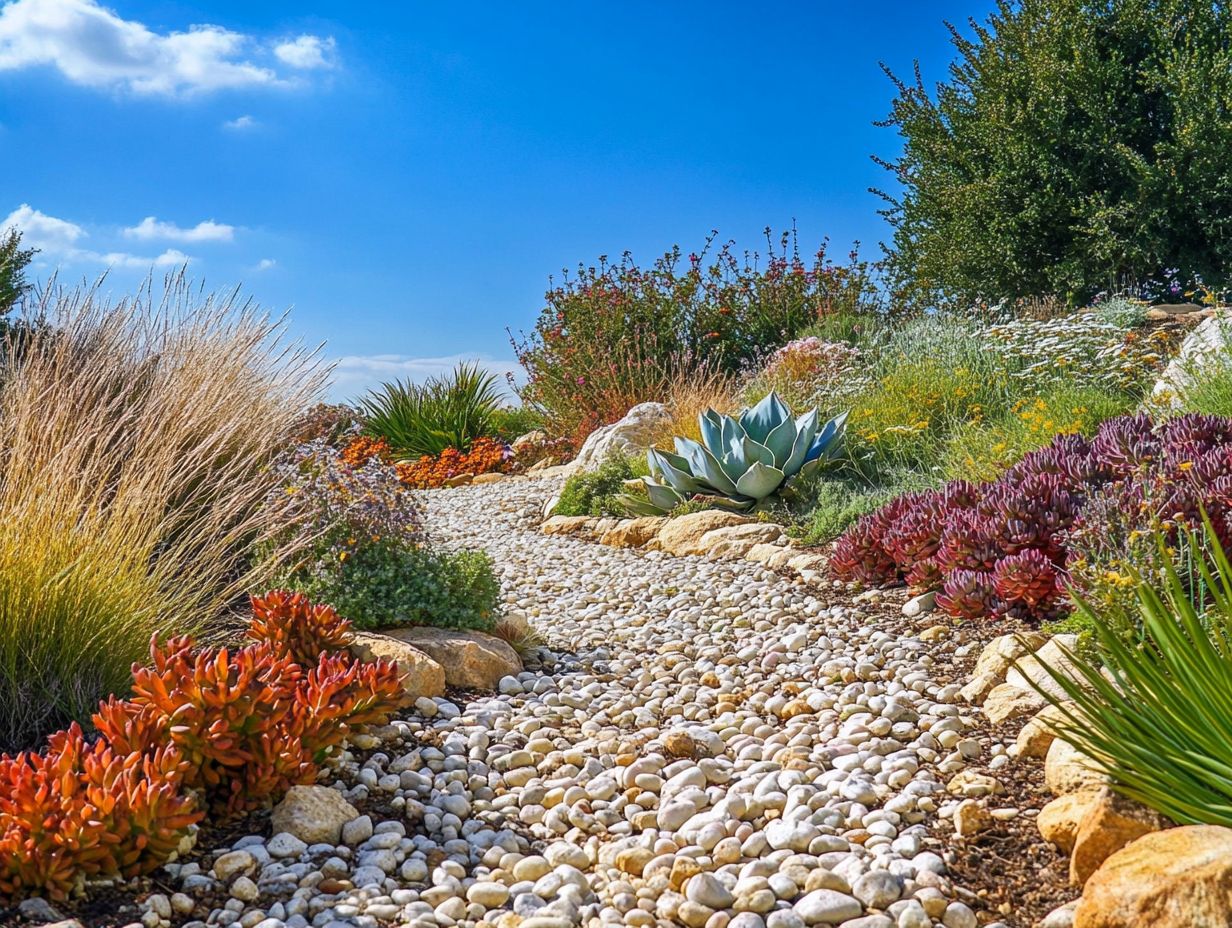
- Choose native plants they save water and support local wildlife!
- Group plants with similar water needs it simplifies maintenance and optimizes water use!
- Use mulch to retain moisture in the soil, reduce evaporation, and suppress weed growth.
1. Choose Native Plants
Choosing native plants is an essential strategy for drought landscaping, particularly in regions like Houston, Texas, and Atlanta, Georgia. These areas often face dry climates that challenge traditional gardening approaches. Incorporating unique features for drought gardens can enhance your landscape. Native plants are perfectly adapted to local conditions, needing less water and maintenance. This makes them the ideal choice for sustainable landscape design.
By opting for these plants, you not only conserve water but also support local wildlife and enhance soil health by adding organic matter. Incorporating native flora can elevate the aesthetic appeal of your garden while promoting effective drought management.
For instance, consider species like black-eyed Susan and Texas sage, which are fantastic options due to their low water requirements and vibrant colors. These plants thrive with minimal irrigation and attract beneficial pollinators like bees and butterflies, enriching the ecosystem around you.
When planning your garden, think about grouping native plants with similar watering needs. Using mulch to retain moisture is also beneficial. Adding features like rain gardens can further enhance your efforts by managing runoff and providing habitats for local fauna.
Integrating native plants into your landscape creates a resilient garden and fosters a deeper connection to the local environment, enriching your outdoor experience and improving your landscape design.
2. Group Plants with Similar Water Needs
Grouping plants with similar water needs is a crucial strategy for crafting an efficient and sustainable landscape. This is especially important in dry climates where every drop counts.
By organizing your plantings in this manner, you can significantly streamline your irrigation routines. This ensures that each type of plant receives precisely the right amount of water no waste, just efficiency. For instance, when you combine drought-tolerant species like succulents, lavender, and ornamental grasses, you optimize water use while elevating the visual appeal of your garden.
This thoughtful arrangement fosters healthier plants, allowing them to thrive in their ideal moisture levels. It also cuts down on the manpower and resources required for maintenance. In the end, your careful grouping of plants will enhance the beauty of your garden and its environmental sustainability.
3. Use Mulch to Retain Moisture
Utilizing mulch to retain moisture is a vital landscaping strategy that elevates soil health, champions water conservation, and promotes healthy grass growth in drought-prone areas.
Mulch offers a variety of options, from organic materials like wood chips, straw, and leaves to inorganic choices such as gravel and rubber. Each type serves specific gardening needs while playing an essential role in moisture retention and regulating soil temperatures.
Organic mulches not only suppress weeds but also decompose over time, enriching the soil with nutrients. In contrast, inorganic mulches provide impressive durability.
For optimal application, aim to spread a 2 to 4-inch layer around your plants, ensuring that it doesn t touch the stems to avoid rot. By incorporating organic matter into your garden beds, you can significantly enhance soil fertility and encourage beneficial microorganisms, creating a vibrant ecosystem that thrives.
4. Install Drip Irrigation Systems
Installing drip irrigation systems is a transformative strategy for your landscape design. This method offers precise water application that greatly enhances water conservation in your gardens.
By delivering water directly to the root zones of your plants, these systems minimize evaporation and runoff. They are particularly effective in areas with drought conditions. Unlike traditional watering methods, which can result in uneven moisture distribution, drip irrigation ensures that each plant receives exactly the amount of water it needs for the best growth.
To set up these systems effectively, assess the specific needs of your landscape, including soil type and the varieties of plants you have. Incorporating timers and pressure regulators (which help control the water flow) can enhance efficiency, while carefully placed emitters allow for a customized water flow.
This method fosters healthier plant development and significantly reduces water waste, aligning perfectly with sustainable gardening practices.
5. Implement Rainwater Harvesting
Implementing rainwater harvesting through systems like rain barrels is a savvy and sustainable practice. It champions water conservation and fortifies the resilience of your landscape design against drought conditions.
This approach entails collecting and storing rainwater using rain barrels or more intricate collection systems that effectively channel runoff from roofs and paved surfaces. By connecting your gutters to these barrels, you can seamlessly capture rainfall during storms, turning a natural resource into a reliable supply. The rainwater you store can then be utilized for irrigation, ensuring that your plants receive consistent moisture even in dry spells.
Integrating harvested rainwater into your water-efficient landscape reduces your reliance on municipal sources and fosters healthy plant growth. Don t miss out on this opportunity to save water and money consider installing rain barrels today!
What Is Drought Landscaping and Why Is It Important?
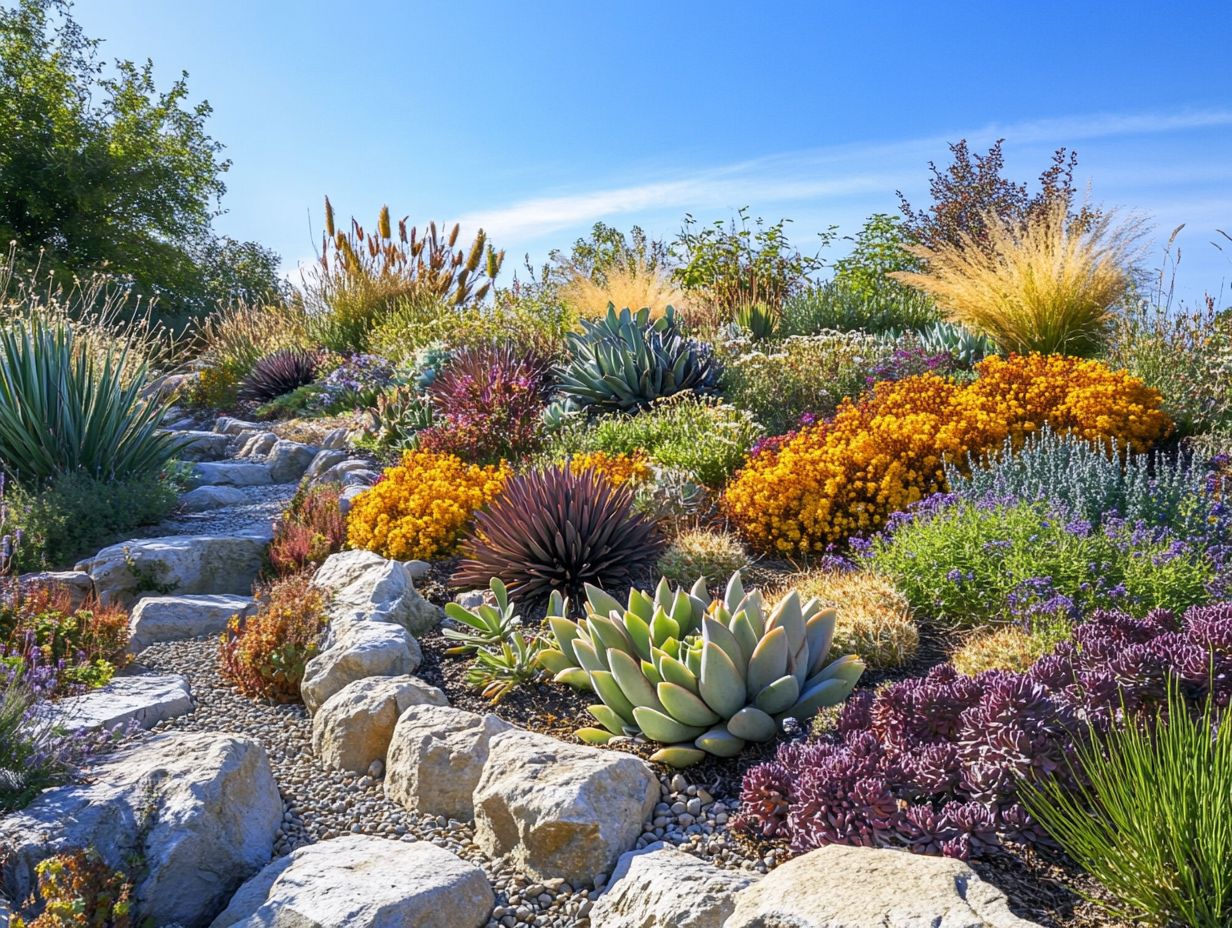
Drought landscaping, commonly known as xeriscaping, is an essential approach to landscape design that emphasizes water efficiency and sustainable plant choices. For inspiration, consider exploring 5 unique drought-tolerant design ideas. This method is essential today in addressing the challenges posed by dry climates and water shortages.
The aim is to cultivate a vibrant environment that enhances biodiversity while minimizing water usage. Unlike traditional landscaping, which often relies on constant watering and extensive maintenance, drought landscaping prioritizes healthy soil and thoughtfully selected plants adapted to your local climate. Incorporating the 5 essential tools for drought-resistant gardening can make this process even more effective.
Incorporating techniques such as mulching, drip irrigation, and the selection of native plants drastically cuts down on water consumption while championing ecological sustainability. For those looking for more detailed guidance, essential tips for planting drought-tolerant species can help transform your outdoor spaces into flourishing habitats while efficiently managing limited water resources.
What Are the Benefits of Using Native Plants in Drought Landscaping?
- Reduced water usage
- Enhanced biodiversity
- Improved soil health through the addition of organic matter
Opting for native plants in your drought landscaping brings a wealth of advantages. These plants are perfectly adapted to your local environment, thriving effortlessly in specific climate conditions without excessive reliance on irrigation or chemical fertilizers. For those looking to enhance their gardens, knowing how to design a drought-tolerant landscape is essential. Their resilience not only eases your maintenance efforts but also allows them to flourish with minimal intervention, making them an astute choice for your landscape design.
By attracting a variety of pollinators and wildlife, native plants play a vital role in sustaining ecosystem balance. Their natural beauty adds a captivating visual element, enhancing the aesthetic charm of your garden or yard while promoting the health of the surrounding environment.
How Can Grouping Plants with Similar Water Needs Help Conserve Water?
Grouping plants with similar water needs is a savvy strategy for enhancing your water conservation efforts. It allows you to implement tailored irrigation practices that minimize waste while ensuring optimal plant maintenance.
By organizing these plants into cohesive clusters, you can significantly boost the efficiency of your irrigation systems. This approach leads to reduced overall water consumption. For example, pairing drought-tolerant succulents with other low-water plants like lavender or sage creates a visually stunning landscape. It also ensures that each plant gets the right amount of moisture without drowning the soil.
This strategy fits perfectly into the goal of creating a sustainable garden. By emphasizing the importance of understanding each plant’s hydration needs, you cultivate a more mindful gardening practice, benefiting both your garden and the environment.
What Are the Different Types of Mulch and How Do They Help Retain Moisture?
There are several types of mulch, each playing an essential role in retaining soil moisture and enhancing your garden’s overall health, especially in drought-prone areas.
Choosing the right mulch significantly impacts moisture levels and the vitality of your plants. Organic mulches, such as wood chips, straw, and compost, break down over time, enriching the soil with valuable nutrients. These materials improve soil structure, encourage beneficial microbial activity, and help keep weeds at bay.
Inorganic options, like pebbles and fabric barriers, offer a longer-lasting solution. They suppress weeds and reduce evaporation, though they don t contribute nutrients.
When applying mulch, aim for a thickness of 2-4 inches and avoid piling it against plant stems. This creates a healthy barrier that mitigates temperature fluctuations and conserves moisture.
What Are the Advantages of Using Drip Irrigation Systems in Drought Landscaping?
Drip irrigation systems present numerous advantages for drought landscaping. They deliver targeted water directly to your plants and significantly enhance water conservation while promoting healthy growth.
Unlike traditional methods that often result in runoff and evaporation, drip irrigation channels moisture straight to the root zones of your plants. This ensures they receive consistent hydration. This method minimizes water wastage and maintains optimal soil moisture levels, essential for sustaining plant health during dry spells.
To set up a drip irrigation system, begin by evaluating your landscape layout and identifying the different types of plants requiring varying amounts of water. Incorporating features like mulch and timers into your system can further enhance its performance.
How Can Rainwater Harvesting Help with Drought Landscaping?
Rainwater harvesting presents an elegant solution for drought landscaping. It enables you to capture and utilize natural rainfall to nourish your garden sustainably.
By installing rain barrels that connect to your downspouts, you can efficiently collect and store rainwater that would otherwise cascade off your roof. You can also use methods like paving that allows water to soak through and rain gardens to enhance this system.
These practices lead to significant reductions in your water bills. They also support local ecosystems by replenishing groundwater supplies.
In areas susceptible to drought, having your own reliable source of water ensures your gardens and landscapes remain lush and vibrant. Start using rainwater harvesting today to make a real difference in your garden’s health!
What Are Some Other Water-Saving Tips for Drought Landscaping?
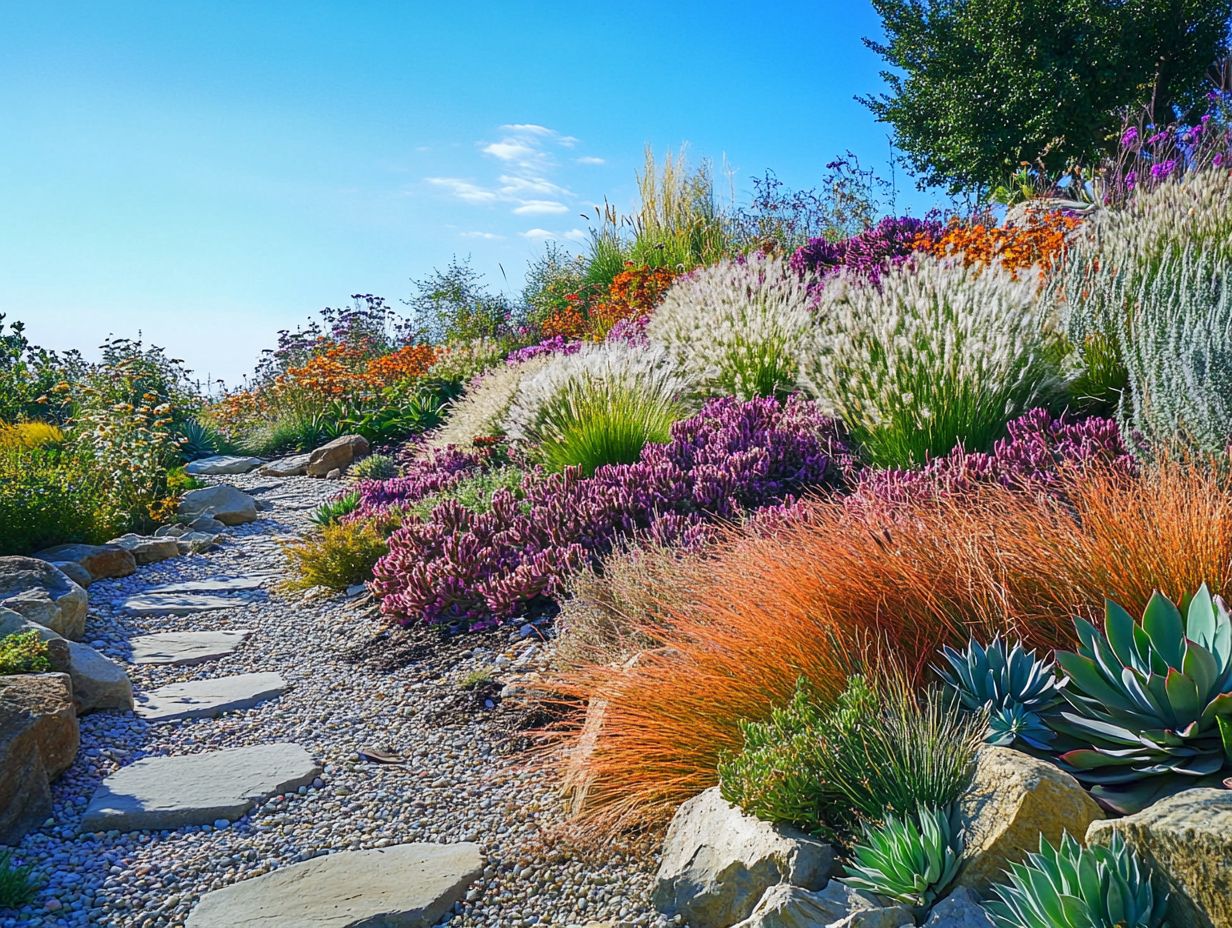
Embrace native plants and efficient irrigation systems. You can also explore 5 tips for maintaining your drought garden that help maintain a lush and sustainable garden. Start implementing these tips today to save water and beautify your space!
Discover how easy it is to select plants that thrive with minimal water. This approach highlights the importance of choosing plants that require less water while using decorative gravel, mulch, and stones to reduce evaporation.
Optimizing grass growth through smart planting techniques like choosing drought-resistant varieties can significantly cut down on water usage while ensuring your lawn remains vibrant and inviting.
Implementing intelligent irrigation practices, such as drip irrigation or rain sensors, ensures that water is delivered directly to the roots only when it s truly necessary.
Together, these strategies not only bolster your individual sustainability efforts but also align with broader drought management goals, promoting a collective commitment to conserving our precious water resources.
Frequently Asked Questions
What does drought landscaping mean?
Drought landscaping uses plants that thrive with limited water, making it essential to know 5 tips for choosing drought-resistant plants. This approach conserves water and reduces the need for irrigation.
Why is drought landscaping important?
Drought landscaping is crucial for conserving water and reducing reliance on irrigation systems. Implementing 5 tips for building a water-wise garden can help maintain a healthy and attractive landscape during times of water scarcity.
What are the 5 essential tips for drought landscaping?
- Choose drought-tolerant plants.
- Use mulch.
- Incorporate water-saving design techniques.
- Regularly maintain and monitor the landscape.
- Be mindful of watering practices.
What are some examples of drought-tolerant plants?
Examples of drought-tolerant plants include:
- Succulents
- Cacti
- Lavender
- Yucca
- Rosemary
These plants have adapted to thrive in dry and arid conditions, making them perfect for drought landscaping.
What are some water-saving design techniques for drought landscaping?
Water-saving design techniques for drought landscaping include:
- Using native plants
- Incorporating hardscape elements
- Utilizing rainwater harvesting systems
- Creating shade to reduce water evaporation
These techniques help minimize the need for water and promote a more sustainable landscape.
How often should you monitor and maintain a drought landscape?
Regular monitoring and maintenance are vital for the health and sustainability of a drought landscape. This includes:
- Checking for signs of pests or diseases
- Removing weeds
- Adjusting watering schedules as needed

